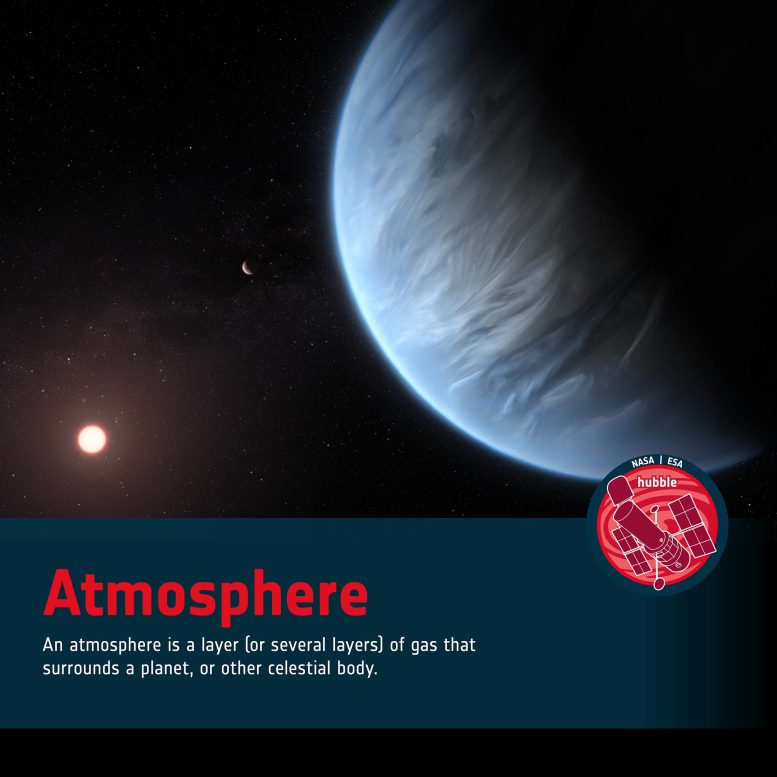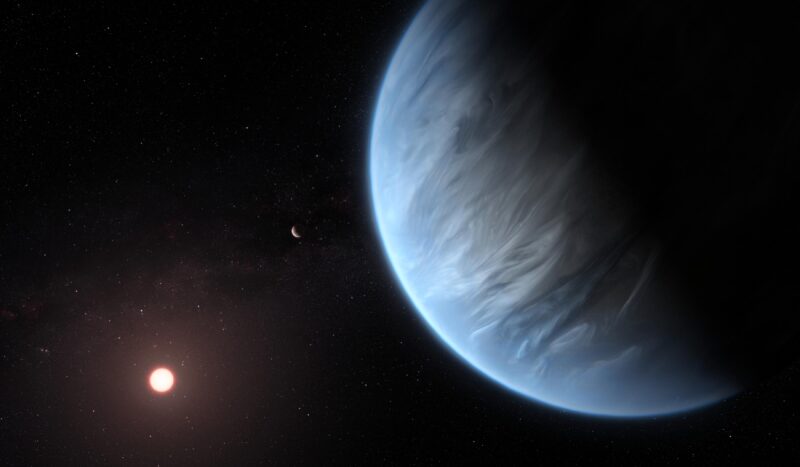
Cette impression d’artiste montre la planète K2-18b, son étoile hôte et une planète accompagnatrice dans ce système. K2-18b est désormais la seule exoplanète super-terrestre connue pour abriter à la fois de l’eau et des températures susceptibles d’accueillir la vie. Les chercheurs de l’UCL ont utilisé des données d’archives de 2016 et 2017 capturées par le télescope spatial Hubble de la NASA/ESA et ont développé des algorithmes open-source pour analyser la lumière des étoiles filtrée par l’atmosphère de K2-18b. Les résultats ont révélé la signature moléculaire de la vapeur d’eau, indiquant également la présence d’hydrogène et d’hélium dans l’atmosphère de la planète. Crédit : ESA/Hubble, M. Kornmesser
Une atmosphère est une couche (ou plusieurs couches) de gaz qui entoure une planète, ou un autre corps céleste.
Si un corps céleste est entouré d’une couche ou de plusieurs couches de gaz, on dit qu’il a une atmosphère. Les atmosphères sont généralement associées à planètes et aux étoiles, bien que d’autres corps célestes puissent également en avoir, tels que les comètesqui ont des atmosphères temporaires. Une atmosphère peut être acquise de différentes manières : elle peut être accrétée sur un corps céleste par attraction gravitationnelle, ou elle peut être libérée d’un corps céleste lui-même dans un processus appelé dégazage. Le fait qu’un corps céleste conserve ou non son atmosphère dépend de la masse du corps et de la température de l’atmosphère. En règle générale, plus la masse du corps est importante et plus l’atmosphère est froide, plus il a de chances de conserver son atmosphère. Par exemple, une planète qui se trouve à proximité d’une étoile, et qui reçoit donc beaucoup d’énergie, peut finir par être dépouillée de son atmosphère – comme ce fut le cas pour Mercure dans notre propre système solaire.
Une atmosphère est une couche (ou plusieurs couches) de gaz qui entoure une planète, ou un autre corps céleste. Crédit : ;” data-gt-translate-attributes=”[{” attribute=””>NASA & ESA
While not one of its original science goals, Hubble has also made a name for itself as an explorer of exoplanets — planets orbiting stars outside the Solar System — in particular by studying their atmospheres. The chemical makeup of a planet’s atmosphere leaves a unique fingerprint on the starlight that passes through it. You can learn more about how Hubble studies the atmospheres of exoplanets in this video.
Hubble made the first detection ever of an organic molecule in the atmosphere of an exoplanet in 2008. Hubble found the tell-tale signature of the molecule methane in the atmosphere of the Jupiter-sized extrasolar planet HD 189733b. Under the right circumstances methane can play a key role in prebiotic chemistry — the chemical reactions considered necessary to form life as we know it. Although methane had been detected on most of the planets in our Solar System, this was the first detection of any organic molecule on a world orbiting another star. This breakthrough was an important step towards one day identifying signs of life on a planet outside our Solar System.

Credit: ESA/Hubble, M. Kornmesser
In 2016 Hubble analyzed for the first time the dry atmosphere of a super-Earth, 40 light-years away. Using Hubble’s data and new analysis techniques, the exoplanet 55 Cancri e was shown to have a dry atmosphere without any indication of water vapor. The discovery indicated that the atmosphere consists mainly of hydrogen and helium.
In 2019, in an exciting discovery, Hubble data were used to detect water vapor in the atmosphere of a super-Earth within the habitable zone. K2-18b is eight times the mass of Earth and at the time of its discovery was the only exoplanet known to have both water and temperatures that could support life.
In 2021, used archival datasets from the Hubble Space Telescope to reveal the first evidence for water vapor in the atmosphere of Jupiter’s moon Ganymede, the result of the thermal escape of water vapor from the moon’s icy surface.


![La plus grande histoire d'origine de toutes : le télescope spatial Webb de la NASA - 29 jours sur le bord [Video]](https://7zine.com/wp-content/uploads/2021/10/1635364609_La-plus-grande-histoire-dorigine-de-toutes-le-telescope-380x250.jpg)
